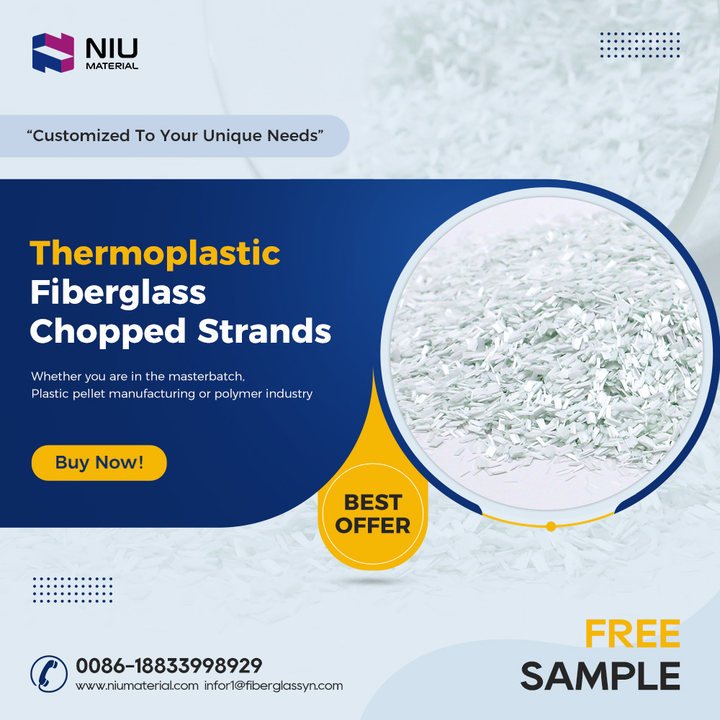- infor1@fiberglassyn.com
- +86-13933702587

Fiberglass chopped strands refer to tiny glass fibers ranging from a few millimeters to several centimeters in length. Compared with long continuous glass fibers, fiberglass shards have a shorter length, but their diameter is usually relatively larger, making them more suitable for strengthening and toughening a variety of composite materials. Chopped glass fiber can be a single fiber or multiple fiber bundles, and its surface can be treated to improve its adhesion to the matrix material.
Chopped glass fiber has many excellent properties, including excellent mechanical properties, corrosion resistance, high temperature resistance and excellent electrical insulation. These properties make fiberglass chopped strands widely used in a variety of fields, from building materials to automotive parts to electronic products.
Next, Niumaterial will delve into the manufacturing process, characteristics and performance of fiberglass chopped strands, as well as its applications in various fields, hoping to provide readers with a deeper understanding and inspiration.
The manufacturing of fiberglass chopped strands is not simple and involves multiple key steps and complex process technologies. Only by strictly controlling every link can we obtain high-quality, high-performance fiberglass strands.
The manufacturing process of chopped glass fiber first requires the preparation of appropriate raw materials. Commonly used glass raw materials include silicate materials, such as quartz sand, limestone, alumina, etc. After a series of treatments and proportions, these raw materials will form the basic material of glass.
The prepared glass raw materials will be sent to the high-temperature furnace for melting. Furnaces usually use resistance heating or gas heating to heat the raw materials to high temperatures so that they are completely melted into a liquid state. During the melting process, the composition and temperature of the glass need to be strictly controlled to ensure the quality and performance of the final product.
Once the glass is completely melted, it is passed through a forming mechanism to form continuous glass fibers. These continuous fibers will be stretched by a drawing machine to make them thinner, and will be cooled during the drawing process so that they gradually solidify into glass fibers.
After drawing, the continuous glass fibers are cut into required lengths to form fiberglass strands. The cutting process can use mechanical cutting or thermal cutting to ensure that the cuts are flat and consistent in length. At the same time, the cut fiberglass chopped strands may require surface treatment, such as coating with surface lubricant or chemical treatment, to improve their adhesion to the matrix material.
Glass fiber chopped strands are a material commonly used to reinforce composites, and their weight is one of the important parameters to consider during the manufacturing process. Typically, the weight of chopped fiberglass strands depends on several factors, including fiber length, diameter, and density.
During the manufacturing process, these parameters need to be reasonably selected according to the actual situation to ensure that the final manufactured composite material has ideal properties and weight.
As a commonly used reinforcing material, the strength of fiberglass chopped strands is one of the parameters that need to be considered during the manufacturing process. The strength of fiberglass strands directly affects the performance and service life of the final composite material.
The strength of chopped strands is affected by the material and manufacturing process of their fibers. Glass fiber itself has excellent strength and stiffness and is a common high-strength fiber material. The manufacturing process determines the surface quality and internal structure of chopped strands, which directly affects its strength and stability.
The strength of chopped strands is also related to their length and diameter. Generally speaking, longer and larger diameter fibers have higher strength. This is because filaments can better share external loads, while larger diameter fibers have higher tensile strength.
Finally, the strength of fiberglass chopped strands is also affected by their surface treatment and the way the fibers are bonded to each other. Surface treatment can improve the adhesion between the fiber and the matrix material and improve the overall strength and stability of the composite material.
In practical applications, the parameters of chopped strands need to be reasonably selected according to specific requirements and engineering needs to ensure that the final manufactured composite material has ideal strength and performance.
As a multifunctional engineering material, fiberglass chopped strands are widely used in various fields. Its excellent properties make it an important component of many composite materials.
In the construction field, chopped glass fiber is often used to strengthen concrete and cement products. By mixing chopped strands with cement or concrete, its tensile strength and durability can be significantly improved, making building structures more stable and durable.
In the automotive industry, fiberglass shards are widely used in manufacturing body structures, roofs, doors and other components. Its high strength and lightweight characteristics can effectively reduce the weight of the car and improve fuel efficiency and driving performance.
In the aerospace industry, fiberglass chopped strands are used as structural materials for aircraft and spacecraft. Its lightweight and high-strength characteristics can effectively reduce the weight of the spacecraft and improve its performance and load capacity. Fiberglass shards are also often used to manufacture aircraft bulkheads, wings, fuselage and other components to ensure the stability and safety of the aircraft.
In the electronics industry, chopped glass fiber is often used to manufacture printed circuit boards (PCBs) and optical fiber communication equipment. Its excellent electrical insulation and corrosion resistance make it an indispensable material in electronic products. Chopped strands can be used as reinforcement materials for PCB to improve its mechanical strength and stability.
In summary, fiberglass chopped strands, as a multifunctional engineering material, are widely used in various fields such as construction, automobiles, aerospace, and electronics. With the continuous development of science and technology and the continuous progress of industry, it is believed that chopped glass fiber will have more and wider application scenarios and make greater contributions to the development and progress of human society.
Chopped strands may be affected by contaminants such as dust and oil during manufacturing and use, and therefore require cleaning and processing to ensure their performance and quality.
Washing is one of the most common, simple and effective cleaning methods. You can soak fiberglass shards in clean water and stir gently with a soft brush to remove dust and dirt on the surface. Be careful not to use a brush that is too hard to avoid damaging the fibers. After cleaning, rinse with clean water and then dry or blow dry with air.
In addition to washing with water, you can also use some chemical cleaners to remove dirt on the surface of chopped strands. For example, you can use a mild detergent or detergent, dilute it and soak the chopped shreds, then gently stir it with a brush, and then rinse it with water. However, it should be noted that when choosing a cleaning agent, be careful to avoid using chemicals that are too strong to avoid damage or corrosion to the fiberglass.
Heat treatment cleaning is a relatively special cleaning method. The chopped strands can be placed in a high-temperature oven for heating treatment, usually at a temperature above 150 degrees Celsius. High temperature can break down and evaporate oil and dirt, making the chopped shred surface clean again.
For some minor surface dirt, you can also use a vacuum cleaner to clean. Set the vacuum cleaner to appropriate suction power and vacuum gently with the nozzle to remove dust and dirt from the surface.
To sum up, the cleaning methods of chopped strands mainly include water cleaning, chemical cleaners, heat treatment cleaning and vacuum cleaning. When cleaning, you need to choose the appropriate method according to the specific situation, and pay attention to protecting the fiber surface to avoid damaging the performance and quality of the fiber.
As a multifunctional engineering material, glass fiber chopped strands have broad application prospects in various fields such as construction, automobiles, aerospace, and electronics. With the continuous advancement of technology and the continuous development of industry, I believe that chopped strands will have more and wider application scenarios.
In the future, Niumaterial fiberglass chopped strands will further develop and innovate in smart materials, eco-friendly and multi-functional materials. At the same time, it is also necessary to pay attention to the continuous optimization and improvement of the glass fiber chopped strand manufacturing process to improve the quality and performance of the material and meet the growing market demand.

If you have any questions
Please contact us for free consultation and product quotation
Table of Contents Add a header to begin generating the table of contents Big 5 Global – Connecting the Future of Global Construction As a
Table of Contents Add a header to begin generating the table of contents Introduce In the composite materials sector, where strength, versatility and reliability are
You can leave your needs and contact information~and We can provide you with usage suggestions + product suitability analysis + free sample delivery!
Leave us your interest and contact information, and we’ll send you detailed information for your reference!
You can leave the specifications and contact information you need~ Our technicians will immediately organize the exclusive information for you and send it to your email!
You can leave your contact information here, and we will send you detailed specifications and application cases to make your purchase clearer~